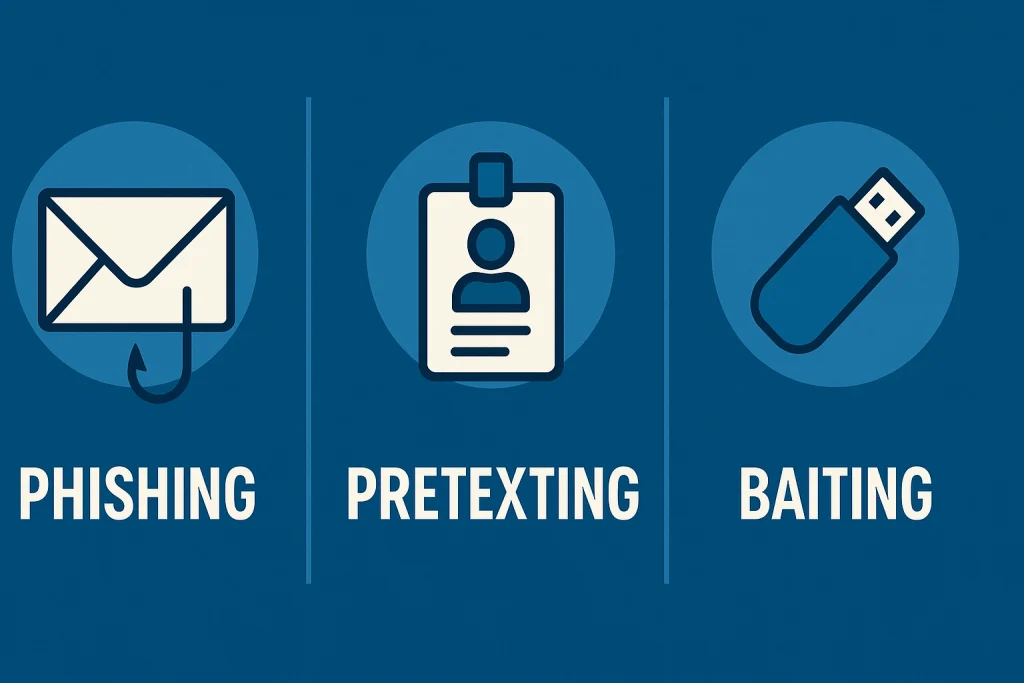What Is Social Engineering? If you’ve ever trusted an email that wasn’t what it seemed or clicked a link that looked urgent, you’ve encountered it. In the digital age, attackers don’t always break into systems with advanced tools. Sometimes, they simply break into people’s trust. That is the power of social engineering—subtle, clever, and often invisible until it’s too late.
In the world of cybersecurity, what is social engineering has become one of the most critical questions. It explains how hackers exploit emotions, habits, and psychology rather than firewalls or passwords. Understanding it means understanding how modern cybercrime operates. It also means giving yourself the tools to fight back. With cyber threats evolving every day, from phishing emails to AI-powered deepfakes, knowing how manipulation works could save your personal information, your job, or even your life savings.
What Is Social Engineering?
What Is Social Engineering is the practice of tricking people into revealing confidential details or performing actions that compromise security. Instead of hacking code, attackers hack human behavior. They rely on trust, fear, urgency, and curiosity. Variations include terms like “human hacking,” “social hacking,” and “psychological manipulation.”
It doesn’t matter how secure your system is; if someone calls pretending to be tech support and convinces you to share a password, the system is compromised. That’s why experts insist the weakest link in any system isn’t software—it’s people.
Breaking Down What Is Social Engineering

Social engineering is an attack on the human mind rather than machines. Attackers use believable stories, fake identities, or urgent requests to trick victims into giving away sensitive information.
For example, an email that looks exactly like a bank warning can push someone to click a fake link and enter their login details—handing credentials directly to attackers.
Common tactics include:
- Phishing – fake emails or messages.
- Pretexting – made-up scenarios to gain trust.
- Baiting – luring victims with free downloads or devices.
- Tailgating – sneaking into secure areas.
- Quid pro quo – offering a fake service in exchange for data.
What makes social engineering so effective is that it feels natural. It exploits human traits like trust, fear, and curiosity, slipping past technical defenses that would normally block obvious malware.
History of Social Engineering
What Is Social Engineering is not new. Long before the internet, con artists and spies used similar tactics. However, technology amplified the scale and speed of attacks.
| Year | Event |
|---|---|
| 1970s | Kevin Mitnick pioneered social engineering techniques |
| 1990s | Email phishing scams became common |
| 2000s | Large-scale corporate phishing emerged |
| 2020s | AI-driven scams and deepfakes added sophistication |
Types of Social Engineering

Social engineering takes many forms, each exploiting human psychology in different ways:
- Phishing – Fake emails, texts, or sites trick victims into clicking links or sharing login details. Spear phishing uses personal info to be more convincing.
- Pretexting – Attackers invent stories or impersonate authority figures (like IT staff) to gain trust and extract sensitive data.
- Baiting – Victims are lured with “free” items such as USB drives or downloads, which secretly deliver malware.
- Tailgating – An attacker sneaks into secure areas by following employees, pretending they forgot their access card.
- Quid Pro Quo – Offering fake help or services in exchange for information, often posing as tech support.
| Type | Method | Example Scenario | Goal of Attacker |
|---|---|---|---|
| Phishing | Fake emails, texts, or websites | Bank email asking to “verify account” | Steal login or financial info |
| Pretexting | False identity or authority-based story | Fake IT staff requesting password | Gain trust to access systems |
| Baiting | Malicious tools disguised as helpful | USB labeled “Salary Data” left in parking lot | Install malware |
| Tailgating | Physical entry via impersonation | Following an employee into a secure office | Access restricted spaces |
| Quid Pro Quo | Exchange of “help” for information | Fake tech support offering free fixes | Extract sensitive data |
How Does Social Engineering Work?
Social engineering works step by step, starting with reconnaissance, where attackers gather details from social media, websites, or public records. Next comes the approach, where they establish trust by pretending to be someone credible—like a coworker, boss, or service provider. Once trust is built, they use psychological tricks such as urgency or authority to pressure the victim into acting—sharing passwords, clicking links, or transferring money. After the victim complies, attackers exploit the access, often moving quickly to steal data or escalate their control. Finally, they may cover their tracks to avoid detection and prolong their presence.
Pros & Cons
Social engineering has clear advantages and drawbacks—for attackers, not victims.
Pros
Easy to execute
Social engineering relies more on human psychology than on technical hacking skills. Attackers often just need a convincing story, email, or phone call to manipulate victims.
Low cost
Unlike advanced cyberattacks that require expensive tools or sophisticated coding, social engineering can be carried out with minimal resources—sometimes all it takes is a fake email address or a spoofed phone number.
Highly effective
Humans are often the weakest link in security. Even the best firewalls or antivirus software can’t prevent someone from clicking on a malicious link or giving away confidential information when tricked.
Cons (for attackers)
Can be detected with training
Employees and individuals who receive proper security awareness training can often recognize and resist phishing attempts, fake calls, and other manipulation tactics.
Leaves digital traces
Many forms of social engineering—like phishing emails or fake websites—leave behind evidence. These traces can be used by investigators to track and identify attackers.
Companies invest in prevention
More organizations are prioritizing security awareness campaigns, phishing simulations, and strong authentication measures. These efforts make social engineering less effective over time.
| Pros | Cons |
|---|---|
| Easy to execute | Can be detected with training |
| Low cost | Leaves digital traces |
| Highly effective | Companies invest in prevention |
Uses of Social Engineering
So, why does understanding what is social engineering matter? Because it affects individuals, corporations, and even nations.
Everyday Scams
Attackers target individuals with phishing emails, fake calls, or fake “lottery” investment schemes. Even ordinary people lose money and trust daily.
Corporate Espionage
Hackers exploit employees to steal data, install malware, or access networks. A single employee clicking a link can put millions at risk.
Political Manipulation
Fake news campaigns, bot armies, and deepfakes influence public opinion. These attacks blur truth and fiction, making social engineering a weapon of influence.
The uses extend into multiple industries. In finance, scammers promise quick wins in the crypto market or coin market to lure investors. In tech, attackers pose as software support offering fake patches. In privacy, users rely on tools like Express VPN, but if they trust the wrong download, even VPNs can’t help. The key takeaway is that what is social engineering thrives in every space where trust exists.
Conclusion
Social engineering thrives on trust and human error, making it one of the hardest threats to fight. The key is combining smart technology with smarter habits. By fostering a culture of skepticism, verifying requests, and training people to recognize manipulative tactics, individuals and organizations can turn awareness into their strongest shield. In the end, staying alert is the most effective way to outsmart social engineers.
Resources
- Kaspersky – What is Social Engineering?
- Norton – Social Engineering Attacks Explained
- CISA – Avoiding Social Engineering and Phishing Attacks
- OWASP – Social Engineering
- IBM – Social Engineering: Definition and Prevention
